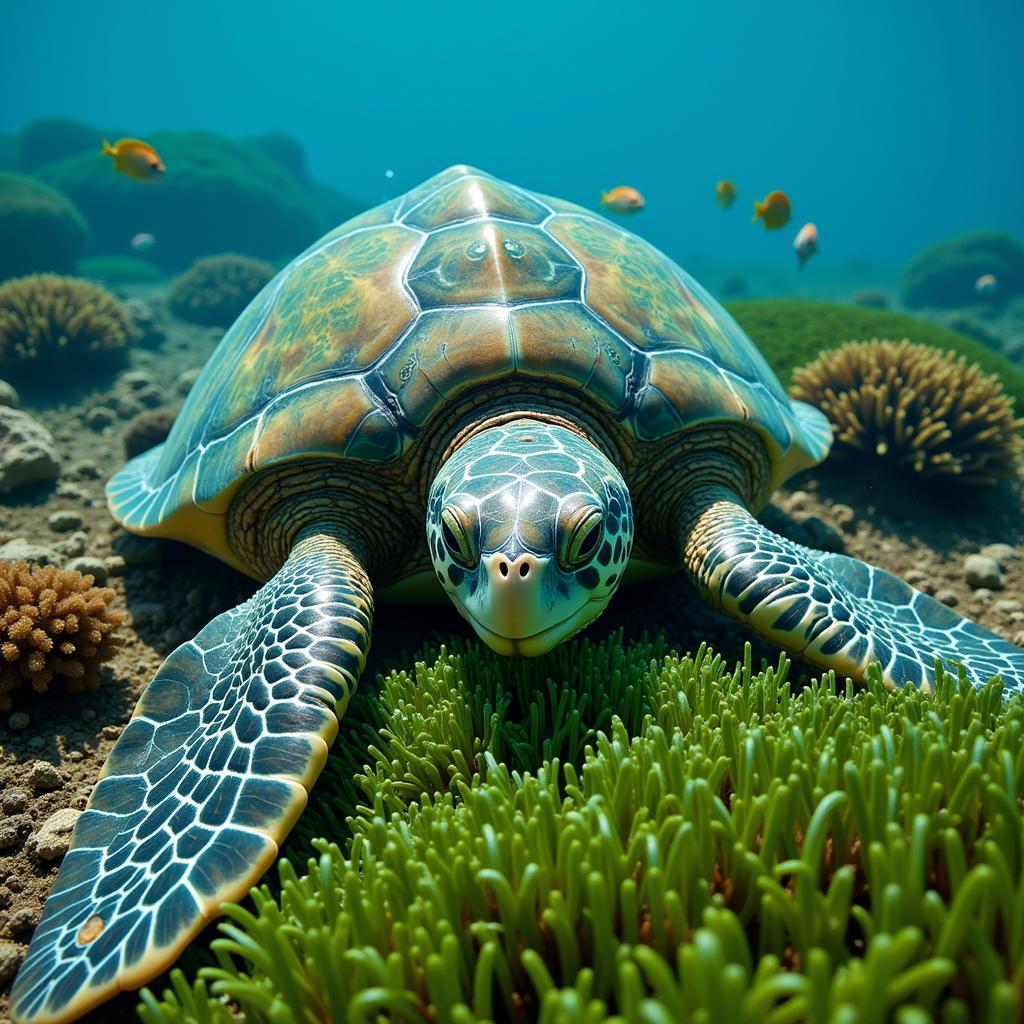The fascinating world of the Food Chain Turtle unveils a complex interplay of predator and prey, varying greatly depending on the turtle species and its habitat. Understanding this intricate system is crucial for appreciating the role these ancient reptiles play in their ecosystems. Let’s embark on a journey to explore what turtles eat and how they contribute to the delicate balance of nature.
Decoding the Food Chain Turtle Diet: Herbivores, Carnivores, and Omnivores
Sea turtles, a group of seven distinct species, exemplify the diversity within the food chain turtle concept. Some are primarily herbivores, grazing on seagrass and algae, like the green sea turtle. Others, like the leatherback, prefer a diet of jellyfish. Then we have the loggerhead, an omnivore with a taste for crustaceans, fish, and even jellyfish. This dietary variety highlights the adaptability of turtles within the food chain. You can learn more about the intricate feeding habits by visiting the food chain for sea turtles.
Herbivorous Turtles: Guardians of the Seagrass Meadows
Green sea turtles, with their serrated jaws, are perfectly adapted for a vegetarian lifestyle. They diligently graze on seagrass beds, playing a vital role in maintaining the health of these underwater ecosystems. Their grazing prevents overgrowth and promotes biodiversity, making them crucial players in the food chain.
Carnivorous Turtles: Masters of the Hunt
The leatherback sea turtle, a giant of the ocean, has a diet primarily consisting of jellyfish. Their specialized throat structures help them trap and consume these gelatinous creatures. By controlling jellyfish populations, they play a critical role in maintaining the balance of marine ecosystems.
Omnivorous Turtles: Adaptable Eaters
Loggerhead sea turtles are opportunistic feeders, showcasing the omnivorous side of the food chain turtle spectrum. They enjoy a diverse diet, including crustaceans, mollusks, fish, and jellyfish. This adaptability allows them to thrive in various habitats and ensures their survival in a constantly changing environment.
 Green Sea Turtle Grazing on Seagrass
Green Sea Turtle Grazing on Seagrass
The Food Chain Turtle’s Place in the Wider Ecosystem
Sea turtles, regardless of their diet, face numerous threats. From habitat destruction to pollution and fishing gear entanglement, their survival is constantly challenged. Understanding their place in the food chain helps us appreciate the cascading effects of these threats on the entire ecosystem. For a deeper dive into the interconnectedness of sea turtles and their environment, you can explore food chain sea turtle.
What eats sea turtles?
Predators of sea turtles vary depending on the species and life stage. Hatchlings are particularly vulnerable, facing threats from birds, crabs, and fish. Adult sea turtles are preyed upon by sharks, orcas, and large fish. Human activities, such as fishing and poaching, also pose significant threats to sea turtle populations.
How do sea turtles impact their environment?
Sea turtles contribute significantly to the health of marine ecosystems. Herbivorous turtles help maintain seagrass beds, providing habitat for a multitude of species. Carnivorous turtles control jellyfish populations, preventing blooms that can harm other marine life. Their role in nutrient cycling and beach dune stabilization further underscores their ecological importance. Check out this resource for more information on the food chain of sea turtle.
Protecting the Food Chain Turtle: Conservation Efforts
Numerous organizations are dedicated to protecting sea turtles and their habitats. Conservation efforts include protecting nesting beaches, reducing bycatch in fisheries, and promoting sustainable fishing practices. Public awareness and education play a vital role in ensuring the survival of these magnificent creatures. More information on the complexities of the sea turtle food web can be found at food chain of sea turtles.
What can we do to help?
Everyone can play a part in protecting the food chain turtle. Supporting conservation organizations, reducing plastic consumption, and making responsible seafood choices are just a few ways to make a difference. Educating ourselves and others about the importance of sea turtles is crucial for their continued survival.
Conclusion: The Food Chain Turtle’s Enduring Legacy
The food chain turtle represents a crucial link in marine ecosystems. From the smallest hatchling to the largest adult, sea turtles play a vital role in maintaining the balance of nature. By understanding their dietary habits and the threats they face, we can take action to protect these incredible creatures and ensure their continued survival for generations to come. The food chain turtle is a testament to the interconnectedness of life and the importance of conservation.
FAQ
-
What do baby sea turtles eat? Baby sea turtles, depending on the species, eat a variety of small organisms like plankton, insects, and small crustaceans.
-
What is the biggest threat to sea turtles? Habitat destruction, pollution, and fishing gear entanglement are among the biggest threats to sea turtles.
-
How long do sea turtles live? Sea turtles can live for several decades, with some species living for over 100 years.
-
Are all sea turtles endangered? Many sea turtle species are listed as endangered or threatened, highlighting the urgent need for conservation efforts.
-
How can I help protect sea turtles? You can support conservation organizations, reduce plastic consumption, and make responsible seafood choices to help protect sea turtles.
-
What is the role of sea turtles in the ecosystem? Sea turtles contribute to the health of marine ecosystems by maintaining seagrass beds, controlling jellyfish populations, and participating in nutrient cycling.
-
What is the food chain of a green sea turtle? Green sea turtles are primarily herbivores, feeding mainly on seagrass and algae.
Need help? Contact us! Phone: 02437655121, Email: [email protected] Or visit us: 3PGH+8R9, ĐT70A, thôn Trung, Bắc Từ Liêm, Hà Nội, Việt Nam. We have a 24/7 customer service team.